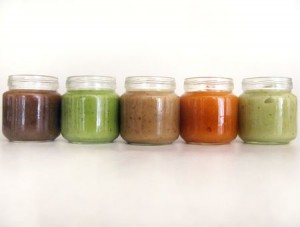 There is ongoing debate and fluctuation in policies when it comes to the introduction of solid foods to an infant’s diet.
There is ongoing debate and fluctuation in policies when it comes to the introduction of solid foods to an infant’s diet.
In this post, I have compiled an overview of the current positions of the World Health Organization, Health Canada, and Pediatric Allergists of the American Academy of Pediatrics. I want to emphasize that this is how I approach the introduction of solids with my patients, but as with many things in life, different people may have different opinions – and that’s ok.
Timing of introduction of solids
The World Health Organization (WHO) recommends exclusive breastfeeding for the first 6 months of life to achieve optimal growth, development and health. Health Canada cites the WHO on its website when it talks about introduction of solids:
“Most evidence suggests that introduction of solids before 2-3 months or later than 6 months has more risks than benefits (Schmitz and McNeish, 1987)”.
Due to the increasing frequency of food allergies in the past two decades, the Pediatric Allergists of the American Academy of Pediatrics in 2008 issued a new position statement based on numerous new articles that showed that delaying of introduction of solids and allergens actually seemed to increase the chance of becoming allergic to that allergen. In that statement, the Pediatric Allergists recommend the introduction of solids anywhere between 4-6 months of age (FR Greer, Pediatric 2008; 121: p 183-191). This is also more in line with the practice of introducing solids in Europe. In January 2013 an updated review reaffirmed this in even more detail talking about when, why and how to introduce solids as well as the introduction of highly allergenic foods (see this review article)
Here’s what I tell the parents of my patients regarding this: When you breastfeed exclusively for 6 months your baby will have enough nutrients to grow healthy, and enough calories to grow well. Most babies are ready to be spoon-fed before that age, in fact a baby could be ready anywhere between the ages 3-6 months. There is no magic switch that turns on at 6 months that is not there before. Being able to eat off a spoon is just as much part of their motor development as rolling over and sitting is. And every baby will do those things at different ages (some early, some late). I recommend offering solids around 4 months of age and to feed with a spoon. If the child pushes the spoon away with its tongue, he or she is not ready yet. Wait 10-14 days, and try again.
You can still continue to breastfeed once you have introduced solids. Please offer the solids first when the baby is hungry, then offer the breastmilk or formula after. If you breastfeed or formula-feed first, the baby will be full and will not want to eat the solids – it’s as if you just had dinner, and then you go out for a second dinner.
Which solid food to introduce first
 Health Canada, the Canadian Pediatric Society and the American Academy of Pediatrics all recommend that iron-containing foods should be introduced first. The most common first iron-containing food to be introduced in North-America is iron-enriched cereal (all infant cereals in Canada are iron-enriched). When the infant has been eating cereal for a few weeks, one can introduce other solids. The order of the solids after cereal is random, but I always recommend offering vegetables before fruits because some babies turn out to have sweet-tooths. Try one vegetable at a time for 2 straight days, then the next vegetable, etc. The most commonly used first vegetables are peas, carrots, sweat potatoes and creamed corn. When you have tried 4 different vegetables and no allergic reactions have occurred (allergic reactions to vegetables are quite rare), one can now introduce fruits in the same way. Start with one fruit at a time for 2 straight days. The most commonly used first fruits are: apples, pears, bananas. After this, one can introduce the combined meat and vegetable combinations such as Turkey/Vegetables, Chicken/Vegetables, Pork/Apple, etc.
Health Canada, the Canadian Pediatric Society and the American Academy of Pediatrics all recommend that iron-containing foods should be introduced first. The most common first iron-containing food to be introduced in North-America is iron-enriched cereal (all infant cereals in Canada are iron-enriched). When the infant has been eating cereal for a few weeks, one can introduce other solids. The order of the solids after cereal is random, but I always recommend offering vegetables before fruits because some babies turn out to have sweet-tooths. Try one vegetable at a time for 2 straight days, then the next vegetable, etc. The most commonly used first vegetables are peas, carrots, sweat potatoes and creamed corn. When you have tried 4 different vegetables and no allergic reactions have occurred (allergic reactions to vegetables are quite rare), one can now introduce fruits in the same way. Start with one fruit at a time for 2 straight days. The most commonly used first fruits are: apples, pears, bananas. After this, one can introduce the combined meat and vegetable combinations such as Turkey/Vegetables, Chicken/Vegetables, Pork/Apple, etc.
I always recommend to try to mimic our diet as much as possible when it comes to what time of day to feed the different solids. For example, cereal would be a breakfast or lunch item, fruit would be a mid-morning and/or mid-afternoon snack, and vegetables (and later the meat/vegetables combo) would be given at dinner time.
Ultimately after cereal, fruits, vegetables and meats have been introduced, the infant will eat 1 bowl of cereal, 1 jar of fruit and 1 jar of meat/vegetables a day. Each one of those 3 solid meals will have replaced a breastfeed/bottle, so one ends up with about 4-5 feeds a day plus those solid meals.
Should I add cereal to the bottle?
Solids should NOT be added to the bottle. An important reason to introduce solids is to help the infant progress further in its development by progressing to more advanced feeding skills, i.e. eating off a spoon instead of sucking from a bottle.
Introduction of table foods
In the second 6 months of the first year, table foods can slowly be introduced such as bread crusts, dry toast, soft ripe fruit, and cheese cubes. But the age of introduction of these table foods is very baby-dependent. Some eat it all at 9 months, and some still gag on those items at this age, and are ready when they are one year old. It is important for both the parent and the health care provider to understand this, so people are not unnecessarily worried about it.
The introduction of unpasteurized honey should not be done before age one.
Peanut butter, however, can now be introduced earlier than age one (AAP 2008 statement as referenced earlier).
Bottomline
- Introduction of solids anywhere between 3-6 months of life, I suggest try to offer it for first time at 4 months;
- Start with (iron-enriched) infant cereal;
- It is not recommended to add cereal to the bottle;
- Peanut butter can be introduced before age one.

 I regularly ask the parents of newborns whether they are supplementing with vitamin D. Most of them do, but not everyone. And there is still confusion whether or not one should supplement with vitamin D if one is formula-feeding.
I regularly ask the parents of newborns whether they are supplementing with vitamin D. Most of them do, but not everyone. And there is still confusion whether or not one should supplement with vitamin D if one is formula-feeding.